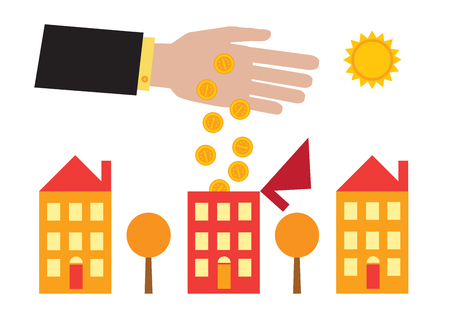1. Understanding Your Financing Options
When financing your first rental property, its important to explore different loan options to find the best fit for your investment strategy. Below, we break down some of the most common financing methods available to real estate investors.
Conventional Loans
Conventional loans are a popular choice for investors with good credit and a solid financial history. These loans typically require a higher down payment (often 20% or more) and have stricter qualification requirements compared to government-backed loans.
Key Features:
- Requires strong credit and financial stability
- Down payments usually range from 20% to 25%
- Lower interest rates compared to alternative financing options
- Strict lending criteria
FHA Loans
An FHA loan is backed by the Federal Housing Administration and allows buyers to put down as little as 3.5%. However, these loans are intended for owner-occupied properties, so you must live in the home for at least one year before converting it into a rental.
Key Features:
- Low down payment requirement (as low as 3.5%)
- More lenient credit score requirements
- Must be owner-occupied for at least one year
- Mortgage insurance required
Portfolio Loans
Portfolio loans are issued by private lenders and kept within their portfolio instead of being sold on the secondary market. These loans often offer more flexibility than conventional loans but may come with higher interest rates.
Key Features:
- Flexible underwriting guidelines
- Easier approval process for self-employed investors
- Higher interest rates than conventional loans
- No strict debt-to-income ratio requirements
Private Lending
If traditional financing isn’t an option, private lending might be a viable alternative. Private lenders are individuals or companies that offer short-term loans based on the propertys value rather than the borrowers credit history.
Key Features:
- Fast approval process
- Short-term financing solution (often 6-24 months)
- Higher interest rates than conventional loans
- Lenders focus on property value rather than borrower qualifications
Comparison of Financing Options
| Financing Option | Down Payment Requirement | Interest Rate | Main Benefit | Main Drawback |
|---|---|---|---|---|
| Conventional Loan | 20-25% | Low to moderate | Lower long-term costs | Strict qualification requirements |
| FHA Loan | 3.5% | Moderate | Easier qualification for first-time buyers | Must be owner-occupied initially |
| Portfolio Loan | Varies (often 10-30%) | Moderate to high | Flexible underwriting guidelines | Potentially higher costs over time |
| Private Lending | No standard requirement (varies) | High | Easier access to capital, quick funding | Higher interest rates and shorter terms |
Selecting the right financing method depends on your financial situation, investment goals, and risk tolerance. Consider consulting with a mortgage broker or lender to explore which option aligns best with your strategy.
2. Building a Strong Financial Profile
Before applying for a loan to finance your first rental property, its essential to understand what lenders look for. A strong financial profile can help you secure better loan terms and increase your chances of approval. Here are the key factors lenders evaluate:
Credit Score
Your credit score is one of the most critical factors in getting approved for a mortgage. Lenders use it to assess how reliable you are as a borrower. Typically, a higher credit score means lower interest rates and better loan terms.
(1) Minimum Credit Score Requirements
Different loan types have varying credit score requirements. Heres a general guideline:
| Loan Type | Minimum Credit Score |
|---|---|
| Conventional Loan | 620+ |
| FHA Loan | 580+ (or 500 with a larger down payment) |
| VA Loan | No official minimum, but 620+ is preferred |
| Portfolio Loan | Varies by lender |
(2) How to Improve Your Credit Score
- Pay bills on time to maintain a positive payment history.
- Reduce credit card balances to lower your credit utilization ratio.
- Avoid opening new credit accounts before applying for a mortgage.
- Check your credit report for errors and dispute inaccuracies.
Debt-to-Income (DTI) Ratio
Lenders also look at your debt-to-income (DTI) ratio to determine if you can afford another loan. Your DTI ratio compares your monthly debt payments to your gross monthly income.
(1) Recommended DTI Ratios
| Loan Type | Maximum DTI Ratio |
|---|---|
| Conventional Loan | 43% (may allow up to 50% with strong compensating factors) |
| FHA Loan | 50% |
| VA Loan | No strict limit, but 41% is preferred |
| Portfolio Loan | Varies by lender |
(2) How to Improve Your DTI Ratio
- Pay off existing debts, such as credit cards or personal loans.
- Avoid taking on new debt before applying for a mortgage.
- Increase your income through side gigs or salary negotiations.
Proof of Income and Employment Stability
Lenders want to see stable income and employment history to ensure you can repay the loan. Self-employed borrowers may need additional documentation.
(1) Common Documents Required by Lenders:
- W-2 forms or tax returns (for self-employed individuals)
- Recent pay stubs or profit-and-loss statements (if self-employed)
- Bank statements showing consistent income deposits
- A letter from your employer verifying job stability (if applicable)
(2) Tips to Strengthen Your Income Profile:
- Avoid job changes right before applying for a mortgage.
- If self-employed, maintain well-documented financial records.
- Add rental income projections if applicable to show additional revenue potential.
By building a strong financial profile, youll improve your chances of getting approved for favorable loan terms when financing your first rental property. Taking steps to improve your credit score, reduce debt, and provide clear proof of income will put you in a stronger position with lenders.

3. Saving for Down Payment and Closing Costs
When financing your first rental property, its crucial to understand the upfront costs involved. These include your down payment, closing costs, and potential reserves. Planning ahead for these expenses can make the buying process smoother and help you avoid financial stress.
Understanding the Key Upfront Costs
(1) Down Payment
Unlike primary residences, rental properties typically require a larger down payment. Most lenders expect at least 20% down, but it can be higher depending on your credit score and loan type.
(2) Closing Costs
Closing costs generally range from 2% to 5% of the propertys purchase price. These fees cover expenses such as loan origination, appraisal, title insurance, and legal paperwork.
(3) Reserve Funds
Lenders may require you to have cash reserves equivalent to several months of mortgage payments. This ensures you can cover unexpected vacancies or repairs.
How Much Should You Save?
The table below provides an estimated breakdown of how much you might need to save based on a $200,000 rental property purchase:
| Expense Category | Estimated Cost |
|---|---|
| Down Payment (20%) | $40,000 |
| Closing Costs (3%) | $6,000 |
| Reserve Funds (6 months of mortgage payments) | $7,200* |
| Total Estimated Savings Needed | $53,200 |
*Assumes a monthly mortgage payment of $1,200.
Tips for Saving Effectively
(1) Set Up a Dedicated Savings Account
Create a separate account just for your rental property savings to keep funds organized and prevent accidental spending.
(2) Cut Unnecessary Expenses
Review your budget and find areas where you can reduce spending. Redirect those savings toward your investment fund.
(3) Explore Additional Income Sources
If possible, take on side gigs or freelance work to accelerate your savings progress.
(4) Consider House Hacking First
If youre open to it, purchasing a multi-unit property and living in one unit while renting out the others can help you qualify for lower down payments and better financing terms.
Savings discipline is key when preparing for your first rental property investment. By planning ahead and understanding these costs, youll be in a stronger financial position when its time to make your purchase.
4. Estimating Rental Property Expenses
Before diving into your first rental property investment, its crucial to understand the various expenses involved. Properly estimating costs will help ensure your rental remains profitable and avoids unexpected financial strain.
Common Rental Property Expenses
Here’s a breakdown of the most common expenses you’ll encounter as a rental property owner:
(1) Mortgage Payments
Your mortgage payment is likely to be your biggest expense. It typically includes principal, interest, and sometimes escrow for taxes and insurance. Understanding your loan terms and interest rate will help you calculate this cost accurately.
(2) Property Taxes
Property taxes vary by location and can significantly impact your profitability. Check with your local tax assessor’s office or use online tools to estimate these costs before purchasing a property.
(3) Insurance
Landlord insurance is essential for protecting your investment. It generally covers property damage, liability, and lost rental income due to covered events. Premiums depend on factors like location, property type, and coverage limits.
(4) Maintenance and Repairs
Routine maintenance and unexpected repairs are inevitable. A good rule of thumb is to set aside 1%–2% of the propertys value annually for upkeep.
Estimated Annual Maintenance Costs
| Property Value | 1% Estimate | 2% Estimate |
|---|---|---|
| $150,000 | $1,500 | $3,000 |
| $250,000 | $2,500 | $5,000 |
| $400,000 | $4,000 | $8,000 |
(5) Vacancy Costs
No property stays rented 100% of the time. Budgeting for vacancies ensures youre not caught off guard when a tenant moves out. A good rule is to set aside 5%–10% of your annual rental income to cover potential vacancies.
5. Maximizing Cash Flow and ROI
When financing your first rental property, optimizing cash flow and maximizing return on investment (ROI) are key to long-term success. By increasing rental income, reducing expenses, and making strategic improvements, you can ensure steady profitability.
Increasing Rental Income
Boosting rental income is essential for improving cash flow. Here are some strategies to consider:
(1) Set Competitive Rent Prices
Research local market trends to price your rental competitively. Consider online tools like Zillow or Rentometer to analyze comparable properties in your area.
(2) Offer Value-Added Amenities
Adding features such as in-unit laundry, smart home technology, or covered parking can justify higher rent rates.
(3) Furnish the Property
If your market supports it, offering a furnished rental can attract short-term tenants and increase rent potential.
(4) Allow Pets with Fees
Pet-friendly rentals can command higher rents. Charging pet deposits or monthly pet fees helps offset potential damages.
Reducing Expenses
Keeping costs low is just as important as increasing income. Implement these cost-saving measures:
(1) Minimize Maintenance Costs
Conduct regular inspections and preventative maintenance to avoid costly repairs down the road.
(2) Shop for Better Insurance Rates
Compare landlord insurance policies annually to find the best coverage at the lowest price.
(3) Optimize Property Management
If hiring a property manager, negotiate fees or manage the property yourself to save on expenses.
Improving Long-Term Returns
Investing in smart upgrades and maintaining tenant satisfaction can enhance long-term returns.
(1) Make Strategic Renovations
Focus on high-ROI improvements such as updated kitchens, modern flooring, or energy-efficient appliances.
(2) Retain Quality Tenants
Avoid turnover costs by keeping reliable tenants happy through responsive maintenance and fair rent increases.
(3) Refinance for Better Terms
If interest rates drop, refinancing can lower mortgage payments and improve overall cash flow.
Cash Flow Optimization Summary
| Strategy | Description |
|---|---|
| Increase Rent Strategically | Adjust pricing based on market research and added amenities. |
| Reduce Operating Costs | Lower maintenance, insurance, and management fees where possible. |
| Enhance Property Value | Make targeted renovations that provide strong ROI. |
| Optimize Financing | Refinance when beneficial to improve loan terms and cash flow. |
By focusing on these strategies, you can maximize cash flow while ensuring long-term profitability for your first rental property investment.


